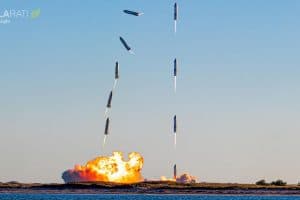Key Points
- 💥 Booster 9 performed a nominal static fire test as SpaceX approached its 2nd integrated test flight.
- 🚀 SpaceX conducted a spin prime test on Booster 9 after it was transported to the Orbital Launch Mount.
- 🛢️ Super Heavy first stage was fueled about an hour before the static fire, with a countdown pause for fuel temperature adjustments.
- 🌬️ FireX system dispersed gases, followed by water deluge system activation before Booster 9’s Raptor engines ignited.
- 🔥 Booster 9 successfully executed a 5-second static fire with the engines shutting down as planned.
- 🚢 Pending good data, Ship 25 might be stacked onto the booster for the launch.
- 🛠️ SpaceX also tested Ship’s quick disconnect and arm swing post static fire.
- 🚫 Hurdles remain, including FAA approval and lawsuits from environmental groups.
- 🗓️ Uncertain if the 2nd test flight could happen in September.
SpaceX’s Booster 9 successfully completes second static fire test as SpaceX progresses toward 2nd integrated test flight.
After relocating from the production site to the Orbital Launch Mount, Booster 9 underwent what appeared to be a successful static fire test, indicating progress toward the upcoming 2nd integrated test flight.
Following a spin prime test, SpaceX examined the rocket before proceeding with the static fire test. The Super Heavy first stage was fueled about an hour before the test, with a hold at t minus 40 seconds to achieve optimal fuel temperatures. The countdown resumed once the desired levels were reached.
At t minus 20 seconds, the FireX system activated to disperse gases, and the water deluge system initiated at t minus 5 seconds. Booster 9 then ignited its Raptor engines, performing a full-duration static fire lasting approximately 5 seconds before planned engine shutdown. While confirmation of all 33 engines igniting was pending, Elon Musk confirmed the success of the static fire.
Pending positive data analysis and booster performance assessment, Ship 25 could be positioned atop the booster at the launch pad. Post-static fire and fuel offload, SpaceX tested the Ship’s quick disconnect mechanism, simulating the process during launch by swinging the arm away.
Before the 2nd test flight, SpaceX must secure approval from the Federal Aviation Authority, and there are ongoing environmental lawsuits against SpaceX that could potentially impact the flight’s timeline.
Given these considerations, do you think a September test flight is a possibility?





